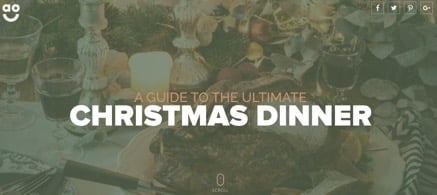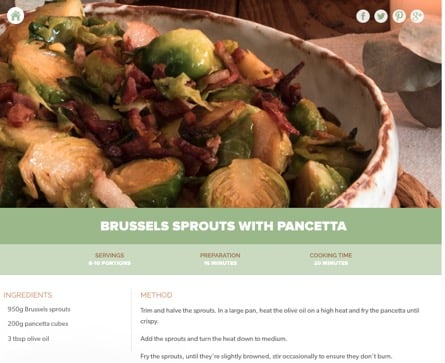
Seasonal events and celebrations present different opportunities for different business sectors. For many brands, seasonal opportunities are huge and often the most commercially critical times of the financial year.
But planning an effective seasonal campaign not only takes a lot of organisation, it also takes a considerable amount of time. For this reason, smaller brands tend to let these opportunities come and go without making the most of them.
Rather than miss out on an opportunity to connect with you audience and leverage the ongoing conversation during any given season, we put together some tips designed to help you get your campaign off the ground. Let's walk through them below.
How to Plan a Seasonal Marketing Campaign: A 5-Step Guide
Step #1: Choose a seasonal opportunity.
When choosing a season to serve as the jumping off point for your campaign, it's important that you're being strategic. In simple terms, one of the key routes to success with seasonal campaigns is using an opportunity that engages your audience. If your audience doesn't engage with the season itself, you can’t expect to see results from a campaign centred around it.
That said, if you have conducted research into your audience, then you’ll likely know their attitudes around these big seasonal events and should be able to pair that with an event that suits your product or service.
Audit Existing Seasonal Campaigns
Once you have decided on a seasonal event to utilise for a campaign, have a look at some of the last few years’ most successful content campaigns for this occasion -- Ahrefs and BuzzSumo are great places to start with this. When evaluating existing, successful campaigns, spend some time thinking about how each piece approached content format, distribution, messaging, and emotion.
When validating a campaign, you might find that it's helpful to ask yourself the following questions:
- How has this piece used multiple content types and distribution platforms?
- Is the messaging clear and if so, what is it?
- What emotion does this campaign evoke in the user?
This type of analysis makes it easier for you to uncover common denominators that may inspire the ideation for your own campaign and contribute to your strategy when planning.
Gather Insights via External Outreach
If you're looking for an outsider's opinion, try doing some outreach to journalists or various digital publications that have previously covered some of the campaigns you analyzed above.
By sending out some feelers to see what kind of content they like to post around your chosen season, and when they like to receive press releases for these pieces, is a valuable way to spend a couple of hours or so.
That isn’t to say you must take the feedback you get as gospel, but it is good to bear in mind when you are planning your seasonal campaign.
Step #2: Nail down the messaging.
As with any marketing campaign, your seasonal campaign messaging is so important. To help you get started, you should be thinking the following:
- The customer journey and the story you want to tell
- The emotions you want to evoke in your audience
- A call-to-action or the desired next steps you want to encourage
In 2013, MegaRed -- a company that sells a type of krill oil supplement that is good for your heart -- launched a noteworthy digital Valentine's Day campaign.
The basis of the campaign was simple: ‘Whose Heart do you Love?’ consisted of a video piece that urged viewers to give the gift of a healthy heart to someone they love on Valentine's Day by applying for a free sample of MegaRed via its Facebook Page. To return the love, MegaRed would send the user a free sample, too.
To add an additional tug on the old heart strings, MegaRed also promised that once 100,000 free samples has been claimed, it would donate $100,000 to the National Coalition for Women With Heart Disease.
When it comes to messaging, this campaign hit on all the points mentioned above:
- The customer journey and the story you want to tell: The messaging focused on new customer acquisition, and pushed the universal importance of hearth health.
- The emotions you want to evoke in your audience: In this case, it was love. MegaRed promoted its product by urging those watching to help their loved ones take care of themselves and their heart.
- A call-to-action or the desired next steps you want to encourage: Request a free sample.
Step #3: Establish a schedule.
With seasonal campaigns, timing is of the essence. This means not only scheduling time to plan well in advance of the event, but also planning the execution of each stage of the campaign at the right time.
With today’s journalists, editors, and site owners receiving hundreds of content pitches and press releases each and every day, you can imagine the influx they receive around peak seasonal times. That said, you need to have your content prepared, built, planned and ready to be sent to sites at least two months before the big event -- preferably sooner.
When creating a schedule for your campaign, don't forget about your audience. When is the best time to contact them? When will they be most willing to share the content or engage with the campaign? Plan around that, too.
Step #4: Organise your assets.
You should consider all marketing platforms -- email, social, PR, blogging, SEO -- when planning your seasonal content campaign, as incorporating different platforms in your campaign allows for an effective content flow, increased reach, and increased engagement.
One of Zazzle’s most successful seasonal campaigns was one done for AO.com, a retailer specialising in household appliances. This simple idea -- ‘A Guide to the Ultimate Christmas Dinner’ -- manifested into a truly successful campaign that spanned many different content formats and platforms.

↓

↓

The hero piece was a content hub that sat on the AO.com blog. This interactive piece greeted the user with 12 of the staple ingredients that make up a Christmas dinner that, when clicked on, lead to a simple recipe on how to cook them -- including both an ingredients list and a methodology. This recipe could then be downloaded by clicking a ‘download recipe’ CTA.
Outside of the content hub, we created an infographic that detailed step-by-step instructions for cooking a Christmas dinner. This was distributed via our blogger relations team to help AO.com's campaign gain traction on related websites.
Then it came down to outreach. And with the help of an organized press release and PR push, this campaign was featured in three different articles -- including spots on Daily Mail, The Huffington Post, and 50 Connect.
Finally, due to the useful nature of the content, it shared well on social platforms, adding to the overall success and visibility of the campaign.
The lesson? Think big picture when planning your campaign assets. By distributing your campaign's message across different mediums and placements, it's easier for folks to find it and share it with their following.
Pro Tip: Having an effective, up-to-date campaign plan document is absolutely essential during this part of the process. It will enable you to better organize the timing and frequency of content release, and keep your messaging consistent by serving as a home for all of your campaign assets and communications. Check out these content marketing planning templates to get started.
Step #5: Report and remain agile.
Something that is imperative when managing and planning a marketing campaign is the ability to be agile. Report and review the campaign’s performance as you go along and adjust your strategy if you feel it's necessary.
Where is the majority of traffic coming from? Which pages have the best bounce rate? Which ones are converting the best? Use these simple metrics, and other campaign success measurements, to inform your strategy moving forward.
Don’t be afraid to make alterations to the original plans. If the changes you are going to make will ultimately improve the campaign’s success, why wouldn’t you make them? Remember: It doesn’t matter that this plan isn’t what you started with.
Getting Started
With 2017 coming at us full steam ahead, begin to think about which seasonal events your brand could benefit from over the next 12 months. After all, nailing these seasonal campaigns could be the key to your best financial year yet.
What are your best tips for planning a seasonal campaign? Share them below.

from HubSpot Marketing Blog https://blog.hubspot.com/marketing/seasonal-marketing-campaign-guide
No comments:
Post a Comment